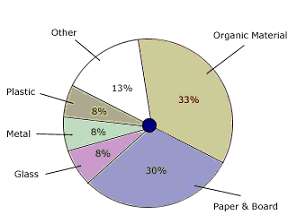 |
| |
Home
:: Myths & Realities |

POINT: Plastics deplete resources
Counter Point: Plastics Conserve
Resource
To pack 500 Grams of Coffee
|
Packing Material
|
Weight
|
|
- Glass
- Tin
-Plastic
|
- 500 gms
- 130 gms
- 12 gms |
|
POINT: Plastics are major
source of solid waste problem.
Counter Point: In developed
economies with disposable lifestyle (eg. W. Europe) plastics
contribute small amount to solid wastes
- Total Solid Waste : 2.8 Billion Tons
- Plastic Wastes : 16 Million Tons
- % to Total Solid Waste : 0.6 %
- 4 Municipal Solid Waste : 137 Million Tons
- Plastic in MSW : 11 Million Tons
- % to Total MSW : 8 %
Source : Dr. William Rathje, University of Arizona Garbage
Project, usa/German federal office.
POINT: Plastics are major
source of solid waste problem.
Counter Point:
Municipal Solid Waste Composition
W. Europe

In developed economies with disposable lifestyle, plastics
contribute only 8% by weight to Municipal Solid Waste (MSW).
The rest consists of organic matter, paper, wood, metal, glass
etc.
POINT: Plastics are major
source of solid waste problem.
Counter Point: Plastic waste
the Indian Dimension
- Lowest percapita
- Consumption
- 4 Highest plastic recycling (Industrial & Urban)
- 4 Plastic in solid waste
- stream lowest
Inspite of low waste volumes industry has taken initiatives
on recycling.
POINT: Ragpickers find thin
gauge plastic bags unviable to collect causing problems in
disposal.
Counter Point:
- Along with Ministry of Environment & Forests (MOEF)
industry has taken initiative on the following :
- Increase the thickness of virgin carry bags to minimum
thickness of 20 microns (vs 5 microns at present)
- Increase the thickness of recycled carry bags to minimum
thickness of 25 microns
- Increased thickness / weight will provide adequate economic
incentives to ragpickers to pickup waste bags & channel
them into the recycling chain which is well established
Plastic bags are already recycled into useful products like
barsati films and mats.
|

